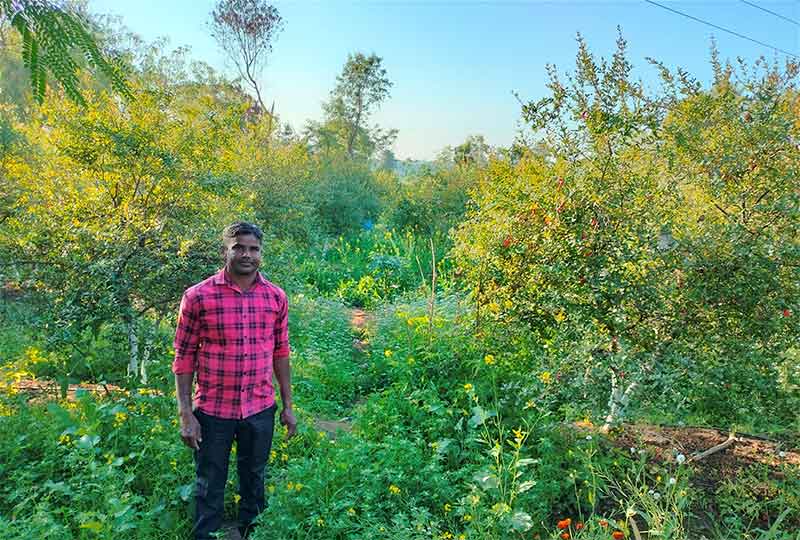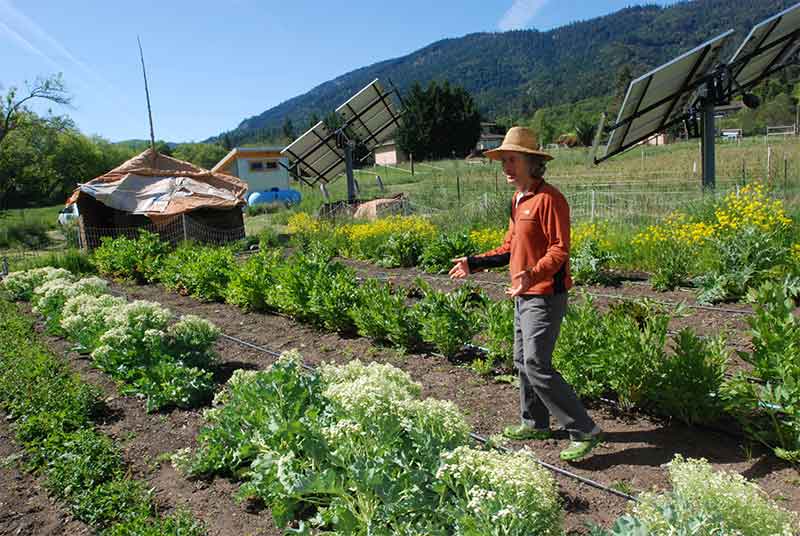
At a time when many of the bigger farmers are complaining of indebtedness and non-viability while also causing ecological ruin, a dalit farmer has shown the way forward by combining highly creative, satisfying livelihood with environment protection. He is very happy working on his farm with his wife and other family members and exploring various creative possibilities. He is able to provide healthy food to his family all through the year, apart from earning the cash for other essential expenses. He is able to educate his two sons in city colleges. He is able to help many other farmers for adopting similar natural farming methods that he has adopted. At the same time he is careful to avoid wasteful expenditure and stays away from liquor and intoxicants, holding liquor responsible for many problems in villages.
I had met Balchand Ahirwar a few months back at the time of an earlier, somewhat hurried visit to his village Lidhoratal in Jatara block of Tikamgarh district (Madhya Pradesh). However I was so keen to know more about his work, approach and thinking that I was keen to return to his farm for a more detailed and relaxed meeting. This opportunity I got only recently in early June. Even though this visit was in the middle of heat wave conditions, there was so much to learn from this farmer that I was very happy to avail of the opportunity of visiting him again.
A key to the successful farming practiced by Balchand and his wife Guddi is that they have reduced their farming expenses as much as possible. In recent years in the case of most farmers expenses relating to chemical fertilizers, pesticides and weedicides have increased very sharply. However Balchand avoids these expenses by making natural fertilizers and pest repellants on his own field using local resources. In the case of natural fertilizer he uses cow’s manure and urine from his own cattle, to which he adds some besan (legume powder) and jaggery. In the case of natural pest repellants he uses leaves having very bitter taste from local trees, mixing these with cow manure and cow urine. Hence while those buying market purchased chemical inputs have to spend Rs. 6000 on an acre of land, Balchand has to spend only Rs. 500. An additional Rs. 2000 per acre is saved on irrigation water as the land using natural fertilizers needs lesser water compared to land using chemical fertilizers.
Other farmers follow the widely prevailing trend of using tractors but tractors are very costly to purchase or hire. Balchand instead uses a power tiller which is several times cheaper but adequate for his small family farm. In addition, he says, he is able to avoid the loss to soil fertility caused by tractors.
While reducing his costs Balchand is careful to utilize every inch of his 2 acre farm in highly creative ways. In the two seasons of rabi and kharif, wheat and groundnuts are the two main crops. Wheat meets the main grain need of his family all through the year while some of this is also sold to earn some cash. Groundnut is mainly a cash crop. However in addition by using limited farm space very wisely Balchand is able to grow a wide diversity of vegetables, legumes, fruits, millets, spices and flowers. We counted up to 44 crops grown within a cycle of one year by him, and there may still be some that we missed. The greatest diversity is in vegetables and a very creative multi-layer garden has been created by him, installing bamboos, so that creepers get more support and the more vulnerable plants can grow in the shade of bigger and sturdier ones. Trees which will be yielding fruits soon also provide shade and moisture to soil and micro-organisms living in soil. Plants and trees on bunds add to the greenery as well as to water and soil conservation. When taking me around the field, Balchand dug up soil with his hands to show how many earthworms were at work within the soil to improve the farm.
Balchand is deeply committed to his farming and even while resting he thinks of what he should be doing in various parts of the small farm. He says that this commitment and the willingness to put in a lot of caring work are essential for the success of natural farming, and those farmers not having a commitment like this are unlikely to be very successful in natural farming. He emphasizes that his work is not drudgery, he enjoys this work. In fact he is so committed to his work and farm that he has shifted his residence from the main village settlement to the farm.
Integral to the success of this farm are the farm animals—4 cows, 4 calves, 4 goats and 1 buffalo. Cows are very essential not just for the higher quality milk but also for cow manure and cow urine. Milk is not sold but kept in the family for meeting nutrition needs.
Balchand has been helped in his efforts by a highly creative voluntary organization called Srijan. Srijan has been trying to spread similar natural farming with special emphasis on multi-layer vegetable gardens and fruit orchards. Those farmers like Balchand who show special ability and enthusiasm are selected for setting up natural farming centers on their farms, just like the Palak Center that Balchand and Guddi have created. Such centers are also used to make natural fertilizers and pest repellants on a much larger scale than what is required by a single farm. These can then be purchased by other farmers ( who have some difficulties in preparing these on their own) at a modest price Even these farmers who purchase natural fertilizers from such centers incur much lower costs compared to chemical inputs, less than half.
By supplying such natural fertilizers and pest repellants to other farmers, Balchand helps them to take up natural farming. He has two brothers, both with 2 acres each like him, and he has successfully motivated both his brothers to take up natural farming.
While Balchand and Guddi shoulder most of the responsibilities, their elders also lend a helping hand. They have two sons who are studying nursing and pharmacy courses in cities of Chattarpur and Bhopal.
Balchand has been honored by the district administration and his services are frequently sought for training other farmers. A training room is available at his Palak natural farming center. Srijan has placed several farming implements here which can be obtained for farming and food processing by other small farmer households.
Balchand has only one small well to meet his irrigation needs and at times, such as in this year’s heat wave, water scarcity is creating problems. This has emerged as an important problem and constraint.
Subscribe to Our Newsletter
Get the latest CounterCurrents updates delivered straight to your inbox.
This kind of farming with a lot of greenery and trees and without any agro-chemicals provides very healthy conditions for many species of birds, bees, earthworms and other friends of farmers to have an increasing and happy presence. This farming promotes biodiversity and is very useful for climate change mitigation as well as adaptation. While trees and porous soil with high and increasing organic content contribute to carbon absorption, giving up chemical fertilizers and pesticides leads to big decrease of fossil fuels. Mixed farming, greater moisture absorption and reduced expenses all lead to climate change adaptation and increasing resilience. Hence such farmers should get big economic support for their efforts and this in turn will help to bring many other farmers on the path of somewhat similar natural farming.
This writer has been trying to meet many such farmers and document their work and experience in remote villages of various provinces. There is so much to learn from the nobility of their efforts and work—perhaps the most creative work. The great value of their work has increased further in times of climate change, and they should receive much higher support.
Bharat Dogra is Honorary Convener, Campaign to Save Earth Now. His recent books include Protecting Earth for Children, Man over Machine, Navjeevan and India’s Quest for Sustainable Farming and Healthy Food.
















































